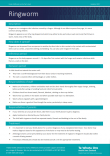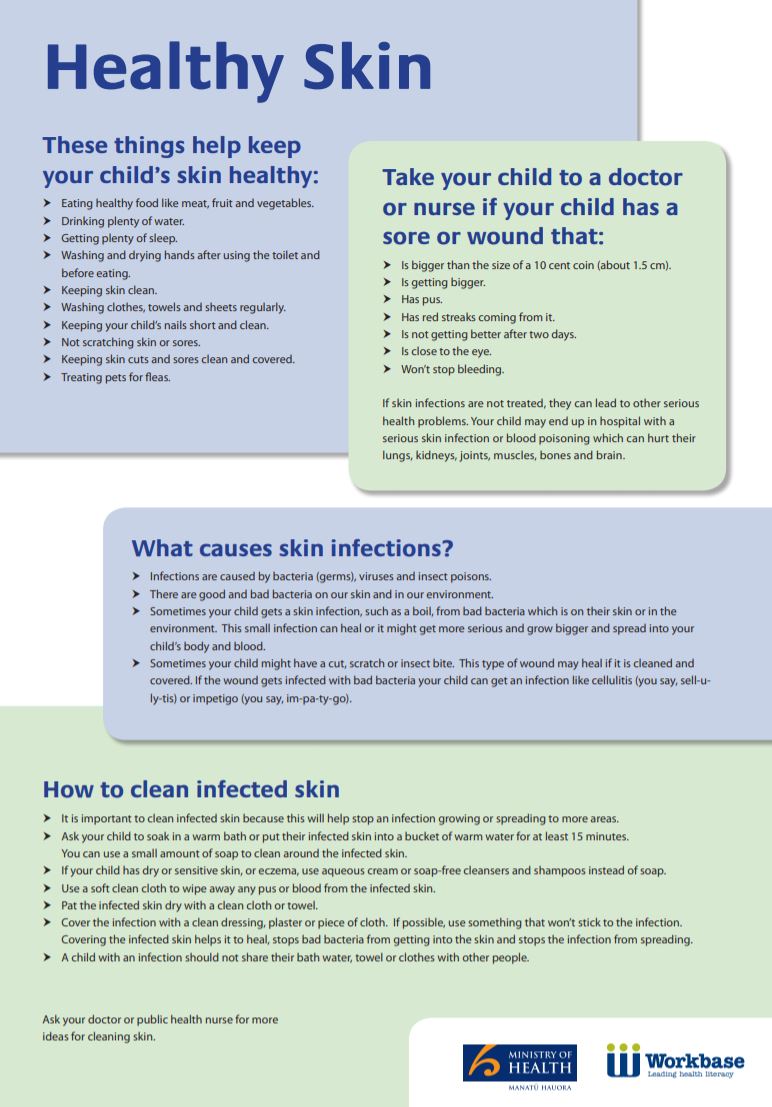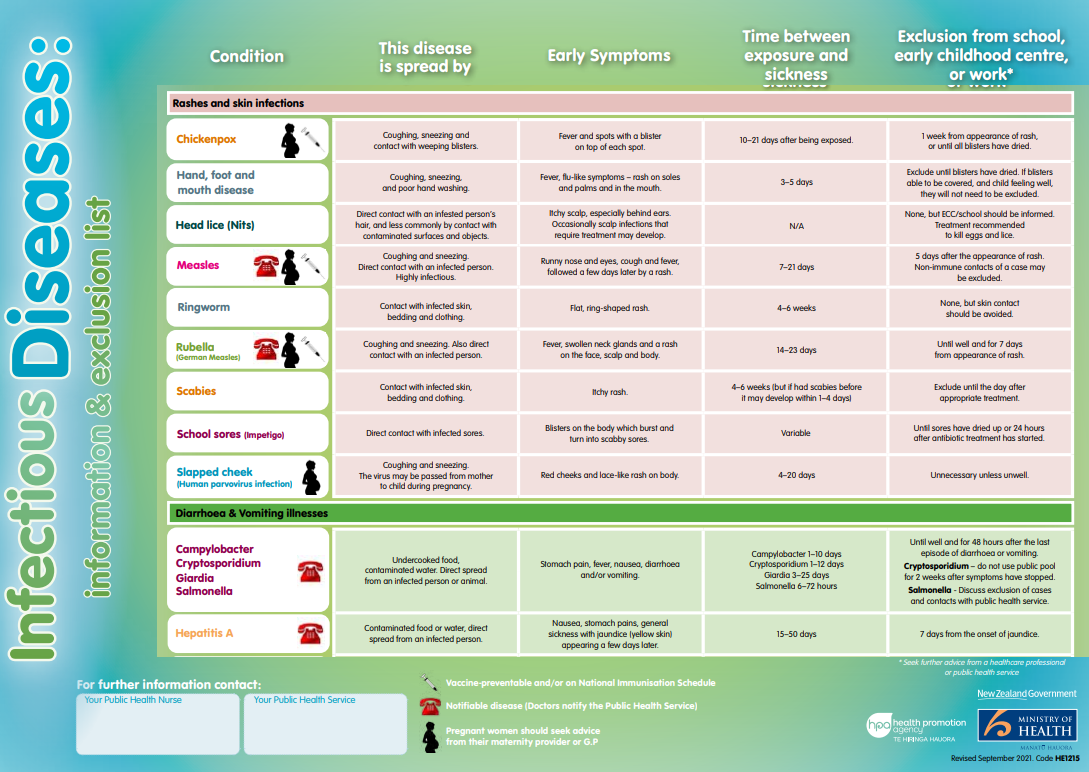Ringworm
Also known as tinea corporis, tinea circinata and tinea glabrosa
Key points about ringworm
- Ringworm is a common type of fungus infection that appears on the trunk of the body, arms, legs, feet, groin or scalp.
- It causes redness, itching, discomfort and a rash.
- Ringworm is not caused by a worm.
- The types of ringworm are known by different names, eg, athlete's foot, jock itch and ringworm of the scalp.
- It's treated with antifungal products.

Ringworm is a common skin infection caused by a fungus and not a worm.
The types of ringworm (also called tinea infections) are known by specific names, depending on the part of the body that is affected. There are some common types of ringworm:
- Athlete’s foot or ringworm of the foot.
- Jock itch or ringworm of the groin.
- Ringworm of the scalp. This can affect adults and children and is also called tinea capitis.
- Ringworm of the body.
The image below shows ringworm on the body.

Image credit: DermNet NZ(external link)
The fungus is easily passed from person to person by contact with infected skin, objects or surfaces. It's possible to get ringworm from:
- having skin-to-skin contact with someone who has it
- petting an animal like a dog, cat, or farm animal infected with ringworm
- touching soil infected with ringworm
- using an infected object like a phone, comb or towel.
The fungi that cause ringworm can live on any infected object, including clothing, hairbrushes and sports equipment for a long time.
You can get ringworm anywhere on your skin including the trunk of the body, arms, legs, feet, groin or scalp. Symptoms of ringworm on the body are:
- redness
- itching
- discomfort
- a ring shaped rash around normal-looking skin.
The infection usually starts as flat, scaly spots with a raised red border that spreads outwards in a circle. The border may be scaly and may blister, while the centre of the area often becomes more normal in appearance with fine scaling. Ringworm is often itchy.
On the scalp, ringworm causes small, painful raised pimple-like bumps. The bumps will spread and leave fine, scaly patches of skin. It also causes bald spots and broken hair. This condition is most often seen in pre-adolescent children.
Apps reviewed by Healthify
You may find it useful to look at the DermDiag app.
Antifungal treatment
Ringworm is caused by a fungus, so it is treated with antifungal products.
Antifungals products come in a variety of forms such as creams, lotion, powder, spray or gel. These can be bought from the pharmacy. The choice of product will depend on where on the body the ringworm appears. It is important to follow the instructions on the pack carefully. Some products need a single application only but others need regular application until after the infection has cleared, to prevent it coming back. Some infections are harder to clear up and might also require an antifungal tablet. These are not available over the counter but require a prescription. If your ringworm is not clearing up with the treatment you are applying to your skin, talk to your doctor about it.
Ringworm on the scalp or beard needs to be treated with antifungal tablets for 1–3 months. Creams, lotions, or powders don’t work for ringworm on these areas.
When should I see a doctor?
See your doctor if your child has ringworm and also has a fever, or if non-prescription treatments from the pharmacy have not worked. Also you need to see the doctor if:
- the affected area becomes larger, swollen, warm, blistered, crusted, smelly or is leaking fluid or pus
- the infection lasts longer than 2 weeks.
How can I care for myself if I have ringworm?
- Do not pick the infected area, it could cause a bacterial infection.
- Check all family/whānau members and pets for ringworm and treat the infection.
- Restrict contact activities, eg, going to the gym or going swimming until the ringworm goes away.
- Your child can go to school or childcare but they should avoid skin contact with other children until the ringworm goes away.
To prevent ringworm, you and your children should:
- Shower or bathe daily.
- Dry your skin thoroughly between your toes and skin folds.
- Avoid sharing towels, clothing or shoes, hair brushes, bedding or headphones.
- Wear jandals or plastic sandals in public pools and changing rooms.
- Wear loose clothing made from breathable materials that draw moisture away from the skin (eg, wool, cotton or leather).
- Avoid clothing made from synthetic material.
- Change your shoes each day and allow them to dry out.
- Wash towels, bathmats, sports clothing, socks and underwear regularly in very hot water (over 60ºC) and dry them well.
- Regularly wash floors (with very hot water and soap) where you walk with bare feet.
Images and more information about tinea corporis(external link) DermNet, NZ
Ringworm(external link) NHS Choices, UK
Ringworm of the skin – topic overview(external link) WebMD, US
Apps
Resources
Ringworm(external link) KidsHealth, NZ, 2022
Keeping skin healthy(external link) Health Literacy NZ
Infectious diseases(external link) HealthEd, NZ, 2023
Brochures

Te Whatu Ora, NZ, 2017

Health Literacy NZ

HealthEd, NZ, 2023
Credits: Healthify editorial team. Healthify is brought to you by Health Navigator Charitable Trust.
Reviewed by: Ministry of Health Public Health Group
Last reviewed:





